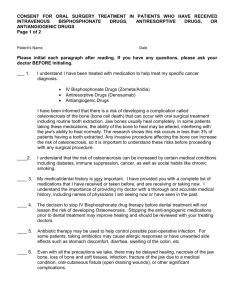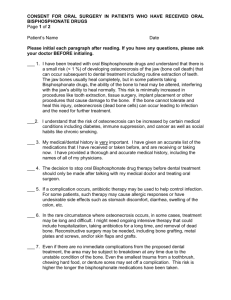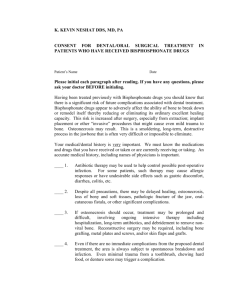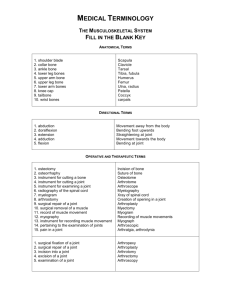Mary Ann Hanlon, DDS, MS Practice Limited to Periodontics 5213
advertisement
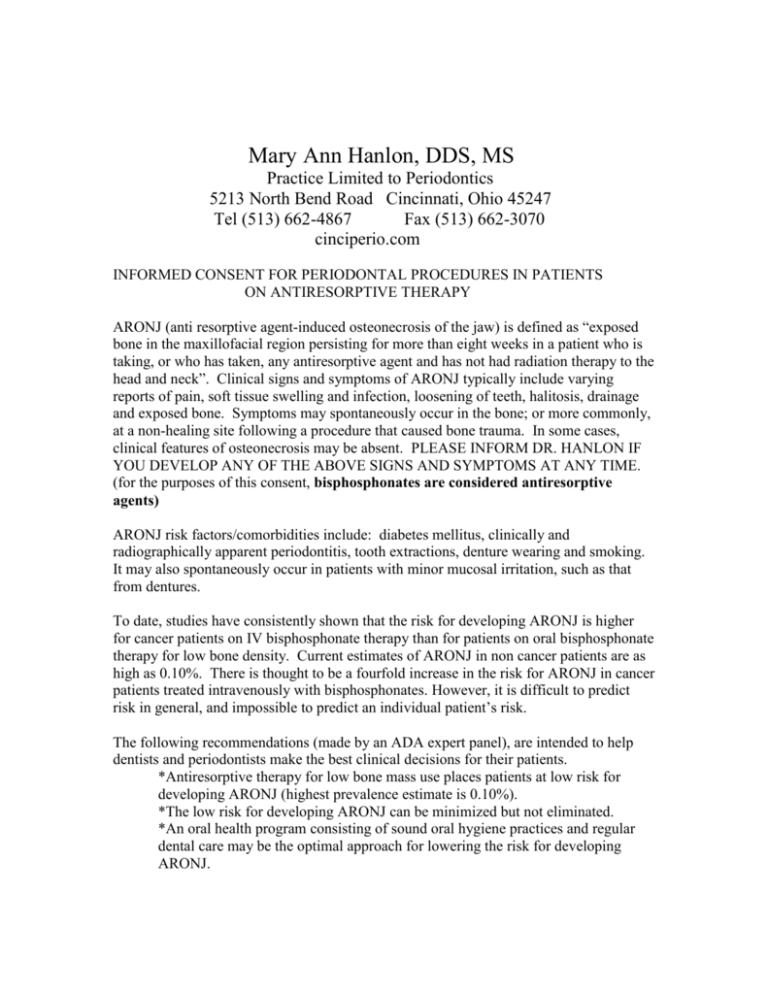
Mary Ann Hanlon, DDS, MS Practice Limited to Periodontics 5213 North Bend Road Cincinnati, Ohio 45247 Tel (513) 662-4867 Fax (513) 662-3070 cinciperio.com INFORMED CONSENT FOR PERIODONTAL PROCEDURES IN PATIENTS ON ANTIRESORPTIVE THERAPY ARONJ (anti resorptive agent-induced osteonecrosis of the jaw) is defined as “exposed bone in the maxillofacial region persisting for more than eight weeks in a patient who is taking, or who has taken, any antiresorptive agent and has not had radiation therapy to the head and neck”. Clinical signs and symptoms of ARONJ typically include varying reports of pain, soft tissue swelling and infection, loosening of teeth, halitosis, drainage and exposed bone. Symptoms may spontaneously occur in the bone; or more commonly, at a non-healing site following a procedure that caused bone trauma. In some cases, clinical features of osteonecrosis may be absent. PLEASE INFORM DR. HANLON IF YOU DEVELOP ANY OF THE ABOVE SIGNS AND SYMPTOMS AT ANY TIME. (for the purposes of this consent, bisphosphonates are considered antiresorptive agents) ARONJ risk factors/comorbidities include: diabetes mellitus, clinically and radiographically apparent periodontitis, tooth extractions, denture wearing and smoking. It may also spontaneously occur in patients with minor mucosal irritation, such as that from dentures. To date, studies have consistently shown that the risk for developing ARONJ is higher for cancer patients on IV bisphosphonate therapy than for patients on oral bisphosphonate therapy for low bone density. Current estimates of ARONJ in non cancer patients are as high as 0.10%. There is thought to be a fourfold increase in the risk for ARONJ in cancer patients treated intravenously with bisphosphonates. However, it is difficult to predict risk in general, and impossible to predict an individual patient’s risk. The following recommendations (made by an ADA expert panel), are intended to help dentists and periodontists make the best clinical decisions for their patients. *Antiresorptive therapy for low bone mass use places patients at low risk for developing ARONJ (highest prevalence estimate is 0.10%). *The low risk for developing ARONJ can be minimized but not eliminated. *An oral health program consisting of sound oral hygiene practices and regular dental care may be the optimal approach for lowering the risk for developing ARONJ. *There is no validated diagnostic technique currently available to determine which patients are at increased risk for developing ARONJ. *Discontinuing bisphosphonate therapy may not eliminate any risk for developing ARONJ. However, it may have a negative impact on the outcomes of low bone mass treatment. Therefore, significant dental risks need to be present to consider cessation of antiresorptive therapy for low bone mass, cancer or other off-label therapies. Discussion with all members of the healthcare team is recommended prior to discontinuing therapy. The patient should be informed of the dental treatment needed, alternative treatments, how any treatment relates to the risk of ARONJ, other risks associated with various treatment options and the risk of foregoing treatment, even temporarily. The patient should be encouraged to consult with his/her physician about health risks associated with discontinuation of antiresorptive therapy. All decisions with respect to utilization of drugs prescribed for medical conditions should be discussed with the prescribing physician. When conservative treatment of dental and/or periodontal diseases has failed, surgical intervention may be the best alternative. Patients receiving antiresorptive therapy who are undergoing invasive surgical procedures should be informed of the risk, albeit slight, of developing ARONJ. Alternative treatment plans should be discussed with the patient, including endodontics, allowing the roots to exfoliate and use of fixed and removable partial dentures. If extractions or bone surgery are necessary, conservative surgical technique, with primary closure, when feasible, should be considered. Before and after any surgical procedures involving bone, the patient should gently rinse with chlorhexidine-containing rinse until healed. There is some evidence that antibiotic prophylaxis may be effective in preventing ARONJ. Your risk of developing ARONJ is very small, unless you are on an intravenous form of antiresorptive therapy. You may be at increased risk for developing other health problems if a dental disease is not treated. Dr. Hanlon has discussed alternative treatments, other risks associated with various treatment options and the risk of no treatment, even temporarily. You have also had the opportunity to discuss any health risks with your treating physician. ____ I have reviewed the above information and have had the opportunity to have any questions/concerns addressed. Based on the information presented by Dr. Hanlon and her staff regarding my diagnosis, the proposed treatment, the treatment alternatives, and the associated risks and complications of such treatment, I request that you perform the planned treatment. Patient Signature Date Doctor Signature Date Witness Signature
